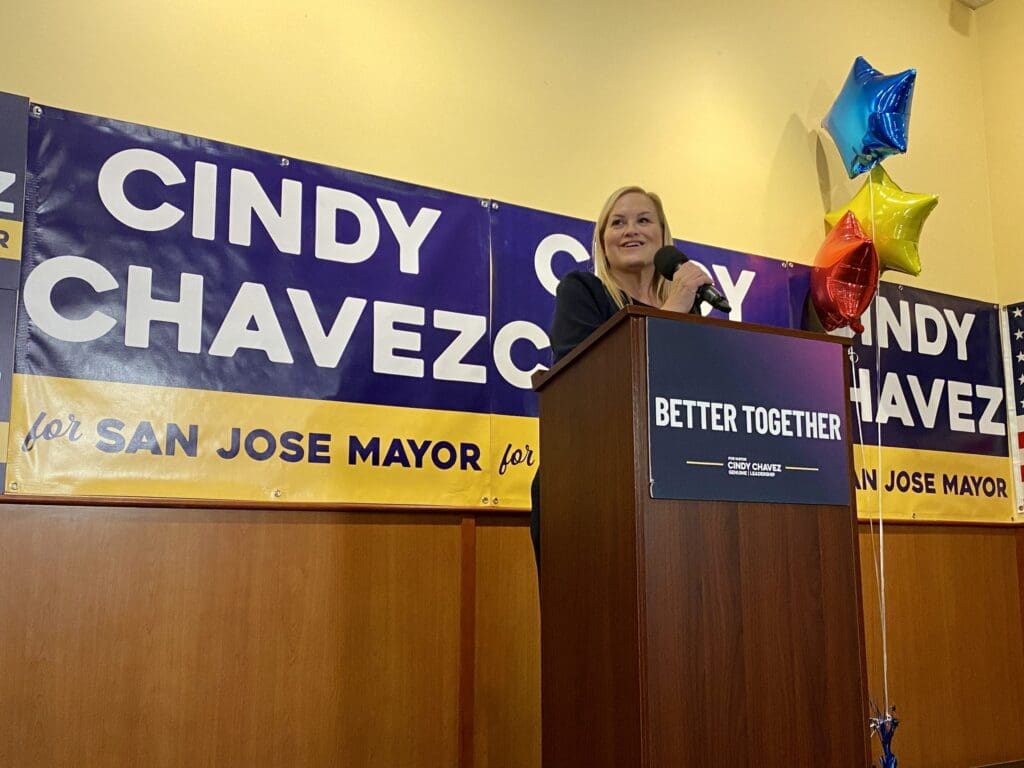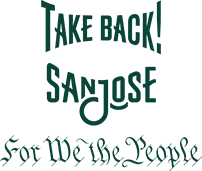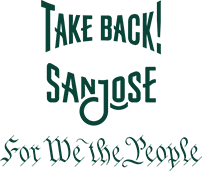
Photo by Tran Nguyen.
A veteran public official with a long list of endorsers and major financial backing had almost every South Bay politico betting on her securing the mayoral seat in the 10th largest U.S. city. Then, she lost.
Days after the November election, it became clear Santa Clara County Supervisor Cindy Chavez had no chance of winning, as her opponent—first-term Councilmember Matt Mahan—continued to widen his lead for San Jose mayor. Despite her experience of more than 20 years, name recognition, support from local and federal leaders, and millions of dollars to propel her campaign, Chavez conceded defeat last week short by roughly 6,000 votes, sending Mahan to the mayor’s office at City Hall.
Mahan’s victory has prompted questions of how a tech entrepreneur with only two years in office pulled off such a win. Community leaders and local politicos said Mahan’s victory stems from a strong canvassing campaign that connected with voters, effective messaging and low voter turnout in East San Jose.
An analysis of voter data by San José Spotlight found Mahan secured a path to victory by mobilizing his base and reaching into areas on both sides of Highway 101 that Chavez won in the June primary. Low voter turnout in areas supporting Chavez also helped Mahan’s campaign, whose supporters showed up to polls on Election Day in larger numbers. Roughly 54% of voters cast their ballots countywide as of this week, compared to 70% voter turnout in the 2018 midterm election and 85% in 2020, according to county data.
“She very nearly won. I think if turnout had been higher, the additional turnout would have been from communities that would have been favorable to her,†Bill James, chair of the Santa Clara County Democratic Party, told San José Spotlight. The party endorsed Chavez.
Although Chavez won 208 precincts compared to Mahan winning 160, her overall voter turnout was considerable lower at 39% compared to Mahan’s at 54% on average.
Message of change
Supporters of Mahan said his message of change and government accountability is what secured his win — and it’s exactly what San Jose voters want.
“San Jose is the most moderate large city in the Bay Area,†Gina Zari, director of government affairs with the California Association of Realtors, told San José Spotlight. The association supported Mahan. “I don’t think Cindy’s politics and her endorsement machine aligned with the voters. Matt’s did. His message of just common sense and moderation and transparency and accountability and accessibility resonated more.â€
The high-stakes competition pitted a veteran public official against a political newcomer touting a message of change. Chavez, who served eight years on the San Jose City Council and nine as a county supervisor, received endorsements from local, state and federal officials and roughly $3.4 million in outside spending. Mahan, with just two years on the council after leaving the tech industry, failed to receive support from any of his council colleagues—nine of whom endorsed Chavez. Only outgoing Mayor Sam Liccardo backed his campaign.
As a newcomer, Mahan effectively painted Chavez as an incumbent blamed for the status quo and all that’s wrong in San Jose — from homelessness to crime — and positioned himself as an agent of change. That his message stuck with fed-up voters, political analyst Larry Gerston said.
“I think people wanted to see change. Not more of the same,†Gerston told San José Spotlight. “Cindy is well known, been in politics and in office for probably 20 years or more. And Matt is relatively fresh-faced, very few people knew yet. So I think it was more a question of not so much what he was going to do, as much as it was him saying we can’t afford more the same.â€


Winning votes from primary candidates
Chavez entered the November election with more advantages. She touted support from prominent business leaders, such as Carl Guardino and the 49ers ownership, and some affluent areas of San Jose.
She dominated nine out of 10 San Jose council districts in the June primary election. Chavez also managed to cut into more conservative neighborhoods in West San Jose in Districts 1, 9 and downtown San Jose—a feat that other progressive candidates such as Dave Cortese in 2014 failed to do when he ran against business-leaning candidate and outgoing Mayor Sam Liccardo.
But that advantage didn’t hold for Chavez in the general election. Mahan successfully flipped many neighborhoods in Districts 1 and 9 in his favor—on top of retaining his base in South San Jose. Mahan also managed to reach into Chavez’s loyal base in Berryessa’s District 4, Santa Teresa in District 2 and part of Evergreen in District 8.
In some areas of Districts 1 and 9 where Chavez lost to Mahan this month, it appears many votes were cast in June for mayoral candidate and San Jose Councilmember Dev Davis, a more conservative policymaker. After Davis was eliminated in the June primary election, those votes went to Mahan. He won almost all the areas where Davis received substantial votes in June, San José Spotlight found, even though Davis ended up endorsing Chavez.
Stronger ground game
Some community leaders said Mahan won areas in East San Jose districts — what should have been Chavez’s base — because he spent more time knocking on doors and attending neighborhood events compared to his opponent.
“Mahan went door-to-door and did the hard work,†Bob Dhillon, a local Sikh leader and former city council candidate, told San José Spotlight. “Personal relationships are the most important. How familiar are you with the community? Did you always show up, or just show up before the elections?â€
Dhillon, who endorsed Mahan, said the mayor-elect frequented the San Jose Gurdwara even before the campaign. During campaign season, Mahan visited the Sikh place of worship 10 times, while Chavez visited around five times only in the latter months, Dhillon said. He also noted the Sikh community does not lean toward business or labor, and instead supports candidates they know best. For example, the Sikh community rallied behind business candidate and former Mayor Chuck Reed and now state Sen. Cortese, who is on the labor side.
Huy Tran, a local labor rights attorney who put his time and money behind Chavez, agrees that personal relationships and the ground game that includes canvassing neighborhoods is what secures victories.
“When it comes to local issues, Vietnamese voters often do not pay as much attention to labels,†Tran told San José Spotlight. “There is much more value placed on who shows up… so if Matt spent more time knocking on doors, he’s just scooping up votes because he had more of that opportunity to connect personally with voters.â€
Low voter turnout
The underwhelming voter turnout in East San Jose continues to haunt the campaigns of progressive candidates this election.
This November, the disparity in voter turnout between East and West San Jose was 21%, with a 41% voter turnout in East San Jose’s District 5 and 62% turnout in West San Jose’s District 10, according to data collected by Political Data, Inc. (PDI), a voter data and campaign software company.
“San Jose had less voter turnout than the county and in Districts 3, 5, and 7—where there were council races—voter turnout was even lower than the city average,†James said. “That means a lot of communities of color, a lot of working class people who live in those contested districts, had much lower voter turnout.â€
Original post for San Jose Spotlight by Tran Nguyen & Jana Kadah

